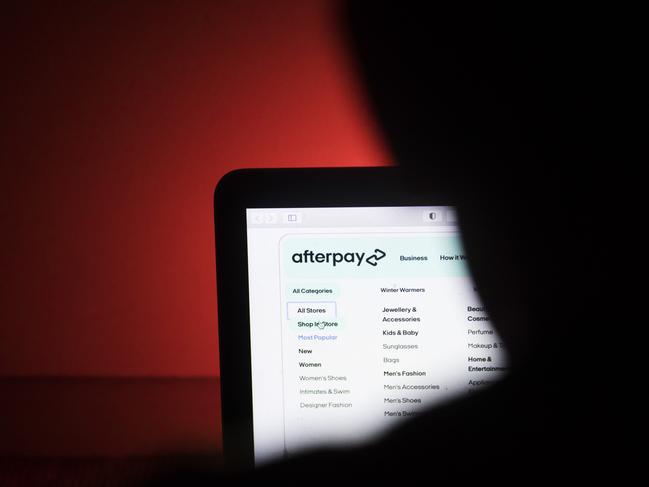As rates rise, BNPL carnage will only worsen
Once over 2.65 per cent, every transaction is under water. And delinquencies are already rising, say analysts who warn pay-in-four products are at risk of becoming loss leaders.

Buy now, pay later instalment products and transactions risk becoming wholly unprofitable for players in the sector, as funding costs surge, bad debts rise and competition heats up.
That’s the view of Fitch Ratings and McLean Roche Consulting who separately warn pay-in-four products are under immense pressure in the current global climate and are at risk of becoming loss leaders, if they aren‘t already.
Fitch’s Michael Taiano, a senior director for banks in North America, told The Australian that competition made it more challenging for platforms to pass on higher costs to merchants, especially the largest ones.
“I view the pay in four product sort of as a trojan horse product that brings in customers that you could then look to monetise with other products/services,” he said.
“I think as a stand-alone product, pay-in-four profitability is challenged, and in order to be profitable will need to scale through repeat customer usage and have low operating expenses especially customer acquisition costs, and have exclusivity with merchants.”
McLean Roche payments stalwart Grant Halverson said BNPL players were in a vicious cycle as funding costs sharply rose and the economy slowed. “It’s a perfect storm and the problem is because they’re unprofitable they’re trying to become profitable. It’s the wrong time for them to do this if they’d been profitable two years ago they would have been in a much better position to weather this,” he added.
Mr Halverson’s analysis suggests as the cost of funding – which is linked to interest rate expectations and bank bill swap rates – hits 2.65 per cent transactions become unprofitable. “That is my number for what I call a pure BNPL transaction, once interest rates get over 2.65 per cent every transaction is under water,” he said. Some were “already underwater now”.
While the one-month bank bill swap rate is hovering around 1.9 per cent, the five month rate is at 2.74 per cent.
The debate comes as Treasury undertakes a review of BNPL to decide whether to classify the product as credit. Roundtables and industry meetings have been taking place ahead of an options paper expected in October.
Large players dispute that they will struggle to navigate the challenging environment and turn profits. Part of their argument centres on the shorter nature of BNPL transactions.
“Afterpay’s receivable book is a very short duration – turning over more than 15 times per year. For this reason, we have the unique ability to manage the cost of capital, have generated attractive returns on our capital and optimise for changes to customer repayment rates,” an Afterpay spokeswoman said.
“Unlike traditional lending, this means our consumer receivables risk exposure is low.”
Zip’s operating chief Peter Gray said the company’s pay-in-four product was efficient as it benefited from capital recycling.
“Any 25 basis point increase in base rate actually only impacts on a transaction by about 2 basis points,” he added. “If rates rose by 2 per cent higher than what they are now the impact of that on a transaction-by-transaction basis is about 20 basis points.
“Should the environment deteriorate a little bit we have a differentiated revenue model compared to some of our peers … we’re well placed to adapt.”
As well as BNPL, Zip also has a more traditional credit product called Zip Money.
Zip – which reports earnings this week – has fast-tracked plans for profitability given the severe market rout inflicted on the sector earlier this year. The company has outlined measures including cutting headcount, increasing monthly fees, closing some units and raising merchant fee
“We have enacted a series of repricing initiatives both on the consumer and the merchant side which will deliver and maintain the margins as they were in a lower interest rate environment,” Mr Gray said.
“There are some remaining on the merchant repricing side.”
One of few analysts with a favourable rating on Zip, Shaw and Partners analyst Jonathon Higgins is upbeat.
He said annual BNPL yields equated to a net interest margin – what is earned on loans minus funding and other costs of – between 10 per cent and 20 per cent.
“The sector should definitely be able to make money, the question is what are they all worth,” Mr Higgins said. “We have a view that they (Zip) will make money and they’ll probably make money sooner than people think.”
But Mr Halverson said while Zip signalled $30m in cost savings he expected higher funding costs would equal more than double that. The savings “will just be wiped away”. Zip’s shares remain a staggering 76 per cent lower this year while Sezzle’s stock remains 73.7 per cent down in 2022.
The banks are also exposed to BNPL sector developments.
National Australia Bank provides separate funding facilities to Afterpay and Zip across Australia and New Zealand, while ANZ is a funder of Humm Group.
Commonwealth Bank and Westpac each fund a smaller BNPL player, and while the former is a shareholder in Klarna it does not provide debt to its local operations. Klarna’s global business is 85 per cent funded by deposits given it’s a bank in Europe.
Latitude – where BNPL comprises just 0.2 per cent of its business – counts CBA, NAB and Westpac among its seven warehouse funders. Latitude on Friday cited $2bn in available headroom across its funding facilities.
Fitch cautions of blind spots for banks given not all credit scoring agencies include BNPL data. “It’s possible that consumers that use BNPL have a higher propensity to default, but (banks) wouldn’t know that unless they have the data,” Mr Taiano said.
BNPL sector competition is getting fiercer as players including PayPal and Apple muscle in.
Apple in June announced its Apple Pay Later service in the US.
“The interesting thing about Apple getting involved in BNPL is that its customers skew toward more affluent, which does not align with the lower income skew for BNPL,” Mr Taiano said, adding competitive and other pressures may lead to further sector rationalisation.
US firm Block last year acquired Afterpay but tough conditions saw Zip and Sezzle abandon merger plans. As interest rates rise and consumers grapple with surging prices, BNPL credit losses are expected to climb. “The issue Zip has got – and all these guys have got is – around bad and doubtful debts,” Shaw’s Mr Higgins said.
Zip and other players also package up loans and BNPL credit and sell bonds as part of their funding mix. The latest investor documents for Zip’s Master Trust, sighted by The Australian, showed 1.54 per cent of receivables in that trust were delinquent by up to 30 days while 1.2 per cent were 31 to 60 days past due. Across Australia, Zip’s arrears at June 30 were 2.3 per cent and net bad debts were 3.82 per cent.
Afterpay’s spokeswoman said the company was maintaining a disciplined risk approach. “Overall gross loss rates are trending well at 1.02 per cent of (gross merchandise value) in Q2, a slight improvement from Q1.”
Fitch said it didn’t agree with Afterpay reporting net charge-offs as a percentage of loan volume originated on the platform given the short-term nature of transactions. Fitch noted credit card issuers and consumer lenders typically reported charge-offs as a percentage of average loans outstanding in a given quarter





